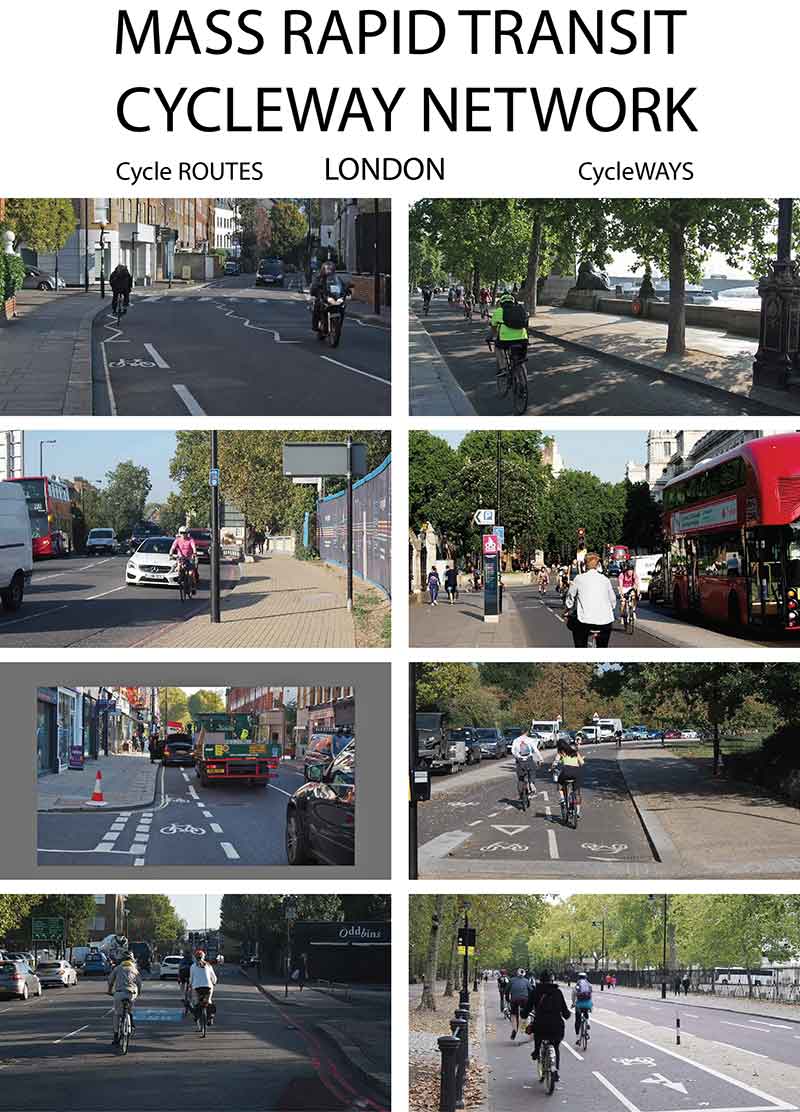Planning a Mass Rapid Transit Cycle Network

The points in this post are illustrated in a short eBook on planning a Mass rapid transit cycleway network for London. It is available for free download at medium resolution (please contact us if you would like a high-res copy). They are also explained in a video and listed below it.
1. The ‘London Cycle Network’ was a set of recommended cycling routes, launched by the GLC in 1981. Planning stopped in 2008 but it is still in use. The LCN uses signposts and road markings to advertise routes on dangerous roads and backstreets. It is a set of fragments not a network of safe cycling facilities.
2. History will see TfL’s post-2015 ‘Cycle Superhighways’ as the first phase of a Londonwide Cycleway Network of dedicated infrastructure. TfL is planning a new network and expressed a hope of completing the first phase in 20412.
3. Cycling is Central London’s fastest-growing transport mode. The use of private cars, taxis and buses is in relative decline. They function increasingly less well because of population growth and consequent congestion.
4. For half the total trips undertaken in London, which are shorter than 8 miles, cycling is the fastest, healthiest, safest, cheapest and most sustainable transport mode.
5. But cycling is the safest mechanised transport mode only because daily exercise helps protect you from obesity, heart disease, cancer, mental illness, diabetes and arthritis.
6. The fatality rate for English cyclists is twice the rate in North European countries with decent cycle infrastructure. This is as unacceptable as it would be if the mortality rate from a surgical procedure were twice as high in the UK.
7. London requires a strategy to create Cycleway Rapid Transit (CRT) system – a Londonwide Cycleway Network. The Network should include leisure routes as well as commuter routes.
8. Strategic Cycleways should be planned, designed and funded by TfL, starting with the construction of cycleways on the 360 miles of the Transport for London Road Network (TLRN). The Red Routes should become Red and Green Routes.
9. Local Cycleways (for journeys to schools, shops, stations, parks, hospitals etc) should be planned, designed and funded by the London Boroughs using traffic calming measures (Mini-Holland/Liveable Neighbourhood etc).
10. Cycleways should be fully integrated with the other sustainable transport modes (bus, rail, walking) to create a Multi-mode Sustainable Transport System.
11. The London Cycleway Network requires funding and phasing. Funding should be related to mode share targets and supported by a Benefit Cost Analysis. Phasing should be ambitious and fast-paced.
12. The mode share of cycling in London should be increased by 2% per year: from 2.2% in 2019 to 14.6% in 2025 and 25% in 203012.
For further information please see
